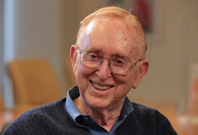 Herb Sandler, along with his late wife Marion, co-founded and ran Golden West Financial Corporation for 43 years. The company reportedly achieved the best long-term earnings record of any company other than Warren Buffett’s Berkshire Hathaway. “We were involved in running what many have described as the best managed financial institution of all time,” says Herb. “One gets an enormous charge from that.” When the Sandlers sold their business in 2006, it never occurred to them not to give the lion’s share of the money away. And yet, Herb’s pride comes from somewhere else. “Anybody can give money,” he says. “But if you have the ability to improve the output of the organization and to make [it] more effective, that’s really exciting.”
Herb Sandler, along with his late wife Marion, co-founded and ran Golden West Financial Corporation for 43 years. The company reportedly achieved the best long-term earnings record of any company other than Warren Buffett’s Berkshire Hathaway. “We were involved in running what many have described as the best managed financial institution of all time,” says Herb. “One gets an enormous charge from that.” When the Sandlers sold their business in 2006, it never occurred to them not to give the lion’s share of the money away. And yet, Herb’s pride comes from somewhere else. “Anybody can give money,” he says. “But if you have the ability to improve the output of the organization and to make [it] more effective, that’s really exciting.”That focus on effectiveness produces great results, and today—on World Asthma Day—it seems fitting to share how the Sandlers’ philanthropy has revolutionized asthma research, a focus area their philanthropy supports.
A personal struggle with asthma inspires a focus on helping all those affected
While Marion’s own struggle with asthma originally put asthma on the Sandlers’ philanthropic radar, Herb says, “from the beginning [we knew] that we would not make any breakthroughs during our lifetime.” Indeed, the Sandlers recognized asthma as a pervasive and critical health issue. According to the American Asthma Foundation, which was established with support from the Sandler Foundation, asthma causes 3,500 deaths in the United States each year and affects 300 million people across the globe, many of whom are children. In fact, asthma is the most common chronic disease affecting children in the United States, which, Herb points out, disproportionately affects low-income children living in inner city areas. In such areas, according to the AAF, asthma has “sky-rocketed.”Despite asthma’s prevalence, the Sandlers found that the field of asthma research and treatment was stagnant: There had been little innovation over the past half-century. Herb and Marion believed that the failure was in part because “the same type of people continue to work on asthma without interjection from specialists and experts in other fields.” So how could the Sandlers disrupt this stagnation? Marion had what Herb calls a “brilliant insight” The answer lay in injecting fresh ideas into the field of asthma by finding a way to attract those who’d—until then at least—had no interest.
See a complete archive or Herb Sandler videos.
Big grants, short applications, fast turnaround times—and ideas from every quarter
The Sandlers, under the American Asthma Foundation Research Program’s national asthma grants program, kickstarted breakthrough research with a three-pronged approach: big grants, short applications, and fast turnaround times. To court innovative researchers and their most promising ideas, the Sandlers offered grants "that would get [researchers] attention," says Herb. They also created a short grant application and instituted a fast approval process. Herb points out that this was in stark contrast to the typically thick applications that researchers had to complete for most grants and the long approval waiting periods that went with them.The response was overwhelming. “We were turning down Nobel laureates,” says Herb. Because the Sandlers’ philanthropic strategy was built on investing over a long time horizon, they also funded significant amounts of “basic” asthma research through the Sandler Asthma Basic Research Center at UCSF (SABRE). To help assess the progress of this research, Sandler uses a separate, expert advisory board.
Unprecedented results
Since focusing on asthma in the late 1990s, Herb is extremely proud of the success they’ve seen. For example, the American Asthma Foundation currently has five drugs in clinical trials as a result of its research program. Sandler points to these drug trials (with more in the wings) and other breakthroughs as a result of the program: “I want you to know, that’s never, ever, ever, ever been done, that in that period of time you've gotten that number of drugs into clinical trials. RelatedThe Sandlers' ProPublica: Muckraker for the 21st Century


